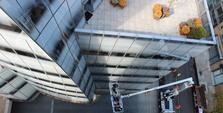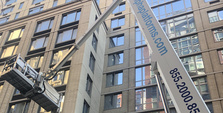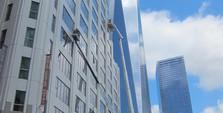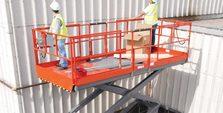Key Definitions for Boom lifts and Scissor lifts
What is Boom Lift?
A boom lift is the same as a man lift, cherry picker, basket lift, aerial lift, or elevated work platform. It's hydraulically controlled and is the highest-reaching elevated work platform that lifts the basket with workers to a certain height. The element is similar to an extending arm, operated from the base part of the machine on the ground. A boom lift is optimal for efficient, reliable, and safe highest-reach access, allowing workers to be raised and moved horizontally and vertically to complete indoor and outdoor jobs.
There are two types of Boom Lifts:
- Articulating Boom and Telescopic Articulating boom lift – a jointed arm bends at one or more places, sometimes called knuckle booms, from the knuckle-like connectors that connect the multiple arms and provide excellent reachability and flexibility. The 360-degree turntable allows rotation in both directions.
- Telescopic boom lift – referred to as a straight or stick boom lift. Its long, straight arm doesn’t bend. A telescopic boom lift has limited flexibility, but is higher than an articulating boom lift, and also moves from side to side. The 360-degree enables seamless sideways and upward-downward movement. It’s perfect for hard-to-reach places.
Alpha Platforms’ hybrid boom lifts can reach heights up to 300 feet.
What is a scissor lift?
This lift is crossed in an X-like pattern when folded and its crisscrossed braces lift up the basket with workers. The braces squeeze like a spring to elevate the platform to the necessary height. These lifts can only move in one direction:up. But they tend to be larger and able to hold more weight. The lift is operated from the base, which needs stable ground to provide proper functionality. Scissor lift platforms usually don’t reach higher than 60 feet.
Two types of scissor lifts:
- Electric and Engine-powered Electric scissor lift - zero emission, silent, electric short lifts designed for enclosed places.
- Engine-powered scissor lift - diesel-powered lifts suited for outdoor jobs, with greater load capacity (up to 2,250 lbs) and larger platforms (79 x 154 in. / 1.95 x 3.92 m) designed to work on uneven surfaces
Boom lift Vs. Scissor lift
Boom Lifts Pros
- Incredible maneuverability for any task in hard-to-reach spaces
- Long, spacious 12-ft cage
- Max cage-lifting capacity 1,540 lbs. (heavy cage)
- Greater lift heights of up to 300 feet
- Side outreach up to 135 feet
Boom Lifts Cons
- Basket holds fewer workers and less weight
- Boom lifts usually cost more vs. scissor lifts
Scissor Lifts Pros
- Largest platform for lifting multiple personnel (6’4’’ x 13’)
- Max. platform load capacity of up to 2,250 lbs (engine-powered)
- Cheaper vs. boom lifts
Scissor Lifts Cons
- Shorter lifts up to 60 feet
- Vertical movement only, no side reach
- Must be placed directly adjacent or under the work area
Boom Lift Vs. Scissor Lift key features
Boom Lifts:
- Efficient working at greater heights
- Enhanced maneuverability to work in hard-to-reach spaces
- Turning cage is perfect for swiveling around any object
- “Up and over'' access: 200 feet up and 100 feet over Unique "under and up" or "up and over and back" access
- Smooth, controlled motions to move close to and around glass and fragile structures
Scissor Lifts:
- Safe vertical elevation of multiple workers to heights up to 50 ft.
- Minimum footprint due to compact unit
- Ergonomic solution and easy-to-use controls
- Strong and stable platforms with a larger basket capacity (vs. boom lifts)
Factors to consider when choosing between Scissor Lift vs. Boom Lift
While we can’t possibly address all of your project’s nuances, as experts, we have determined the following top considerations to help decide between a boom lift vs. scissor lift.
Top 6 Factors when Choosing Boom Lifts vs Scissor Lifts
- Height
- Direction
- Obstacles
- Location
- Number of workers
- Budget
Consider the height you need to achieve and the capabilities of boom lifts vs. scissor lifts. Since scissor lift platforms rarely go higher than 60 feet, they are mostly suitable for residential projects and inside buildings. Boom lifts offer higher reach vs. scissor lifts, with telescopic boom lifts offering four to five times the height of scissor lifts - up to 300 feet. Commercial cleaning, cell tower repairs, and construction are often done with the assistance of boom lifts.
- Determine direction(s) capabilities of boom lifts vs. scissor lifts. If you need to go only straight up and down, a scissor lift could be a good option. Otherwise, if you need a wide range of motion that requires substantial side reach, and "under and up" or "up and over and back" access, boom lifts are an excellent choice. That’s because boom lifts possess unique features that enable flexible maneuvering to access tough-to-reach areas.
- Are there any obstacles at the location? In terms of maneuverability between boom lifts vs. scissor lifts, the scissor lift’s limited strict vertical movement makes it less capable of maneuvering around obstacles. A boom lifts’ extreme side reach of almost 135 feet enables work over city construction, excavation, or coverage of over 4,000 square feet of building façade surface from one setup position. A huge upper boom can reach over an angled roof 200 feet high and 100 feet over, while the turning cage is perfect for swiveling around most structures.
- Match the suitability of boom lifts vs. scissor lifts with the conditions of the project’s location. For inside jobs, scissor lifts might be suitable, especially if the floors are fragile. Boom lifts are larger, heavier, and must be vetted with building management. Both engine-powered scissor lifts and boom lifts can be effective on uneven terrain.Boom lift platforms are mounted on an all-wheel drive, rough terrain chassis, and are ready for work in rugged environments. They are equipped to face any challenge, from various city jobs to oilfield projects in extreme conditions.
- How many workers does the boom lift vs. scissor lift need to accommodate? Back in the day, boom lifts were often created to lift one person and some tools. With Alpha Platforms’ 12-foot wide work cage’s 1,360 lbs weight capacity that accommodates 6-7 people, a generous height reach of up to 300 feet, and great side outreach, these lifts quickly gained favor among professionals working at heights. And if you need to accommodate heavy materials with several workers at once - you can use a scissor lift with a large platform and a load capacity of up to 2,250 lbs (often engine-powered).
- What is the budget? Since boom lifts versatility and functionality at more extreme heights means they are typically more expensive. With all other requirements being equal, for heights under 50 feet, it’s more cost-effective to choose a scissor lift vs. boom lift and save.
For some projects, a scissor lift may do part of the job, but you still need a boom lift to complete it. This is where deciding between a scissor or boom lift is challenging.
The good news is Alpha Platforms addressed that pain point by offering a solution for urban work that overcomes all obstacles and addresses hard-to-reach places. Considering its size and impressive maneuverability, our boom lifts are an ideal cost solution and a superb option compared to the highest lifts, or renting a scissor + boom lift.
Scissor Lift vs. Boom Lift: Q&A
Do I need a license to operate boom lifts vs. scissor lifts?
Anyone operating a scissor or boom lift must be licensed and trained. OSHA (Occupational Safety and Health Administration) requires lift operators to complete a special certification process.
How much do boom lifts vs. scissor lifts weigh?
Scissor lifts can weigh between 8,000-17,000 lbs, depending on the model’s height capacity. For electric lifts, the total weight of the lift and its load capacity should be taken into account. The tallest 300-ft boom lift weighs 110,900 lbs and the smallest 120-ft boom lifts weigh 19,500 lbs. All Alpha Platforms' boom lifts have different weights, with the average being about as much as a firetruck, and have been built to meet all US road standards (Federal and State). For indoor projects, the permissible limits should be calculated so that the surface can withstand them. Some Alpha Platforms' boom lifts have been cleared for indoor projects (e.g., an indoor waterpark).
Can a scissor lift tip over?
Both lifts can overturn under the wrong circumstances or operation. This can happen if the load is off center or if a worker leans out of the lift, i.e., if the center of gravity is off. It is important to consider stabilization strokes and follow clear safety and lift operation guidelines of scissor lifts. Alpha Platforms’ boom lifts have redundant factory-installed safety systems that prevent them from tipping over.
What projects are best suited for boom lifts?
- Cleaning and maintenance
- Sign installation and removal
- Commercial painting
- Utilities and electric work
- Cell phone antennas
- Bulb replacement projects
- Tree cutting/trimming
- Bird protection
- Demolition projects
- Roof surveys
- Building facade inspection
- Building facade repairs
- Aerial photography
- Pest control
- Glazing and window repairs
- General construction
- HVAC and duct projects
- Film and television
- Stadiums and arenas
- Airports
- Highway & bridge inspection
What is your next step?
Having reviewed the core points, features and advantages of boom lifts vs. scissor lifts, and considered important factors in choosing an aerial platform, you can now make an informed decision.
If you decide that a boom lift fits your needs, Alpha Platforms offers a range of boom lifts that meets the needs of most projects at heights.
Have You Tried Operated Boom Lift Rentals?
Alpha Platforms offers a no-hassle, all-inclusive height access solution for inspection, maintenance, repairs, and other projects at heights.
- IPAF-certified and manufacturer-certified full-time operators.
- German-engineered aerial platforms are custom-built to US codes and standards.
- Best-in-industry service: permit procurement and traffic management.
Read more about Operated Rentals or call now at 855-2000-855
Find out why Alpha Platforms is your best choice for height access solutions









